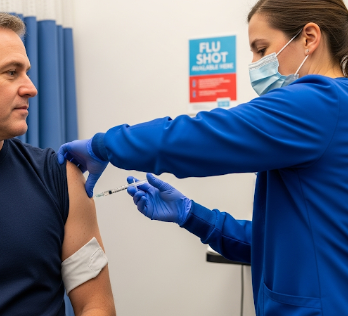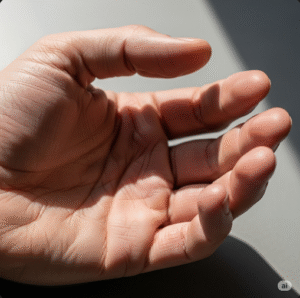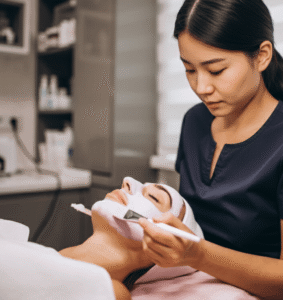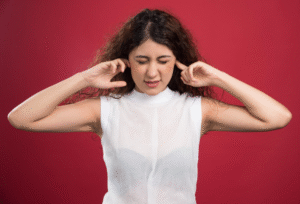What is the Flu Vaccine?
The flu vaccine, also called the influenza vaccine, is a preventive immunization that protects against seasonal influenza viruses. It stimulates the immune system to recognize and fight influenza strains, reducing the risk of infection, hospitalization, and complications.
💡 Types of Flu Vaccines:
✔️ Inactivated Influenza Vaccine (IIV) – Contains killed virus; administered via injection
✔️ Live Attenuated Influenza Vaccine (LAIV) – Contains weakened virus; nasal spray, mainly for children
✔️ Quadrivalent Vaccine – Protects against four influenza virus strains (two A, two B)
✔️ High-Dose Vaccine – Designed for adults aged 65 and older for stronger immune response
Key Fact: The flu vaccine is updated annually to target the most common circulating strains predicted for each season.
In Korea, flu vaccination is widely available at public health centers, hospitals, pharmacies, and clinics, and is included in government programs for high-risk populations.
Why It’s Done
The flu vaccine is recommended to protect individuals and communities from seasonal influenza and its complications.
✔️ Prevent influenza infection – Reduces illness risk
✔️ Reduce hospitalization – Especially in elderly, children, pregnant women, and immunocompromised individuals
✔️ Prevent severe complications – Pneumonia, bronchitis, and exacerbation of chronic diseases
✔️ Protect vulnerable populations – Limits virus spread to infants, elderly, and patients with chronic conditions
✔️ Decrease economic burden – Fewer missed workdays and healthcare costs
Clinical Benefits:
➡️ Lower infection rates → Significant reduction in seasonal influenza cases
➡️ Reduced severity → If infection occurs, symptoms are generally milder
➡️ Community immunity → Protects high-risk groups through herd immunity
➡️ Global public health support → Annual vaccination contributes to outbreak prevention
In Korea, annual vaccination campaigns target school children, healthcare workers, elderly, and people with chronic illnesses, ensuring widespread protection.
Alternatives
While the flu vaccine is the most effective preventive measure, alternatives or supplementary measures include:
⭐ Good hygiene practices – Handwashing, covering coughs, and avoiding close contact
⭐ Antiviral medications – Oseltamivir or Zanamivir for post-exposure prophylaxis or early treatment
⭐ Healthy lifestyle – Balanced diet, adequate sleep, and regular exercise to boost immunity
⭐ Masks and social distancing – Reduce exposure during flu season
👉 Key Point: These measures support prevention but do not replace vaccination, which remains the primary protective strategy.
Preparation
Preparing for flu vaccination is simple but important for safety:
🔹 Medical history review – Allergies (egg, gelatin), previous reactions, chronic conditions, pregnancy status
🔹 Current illness assessment – Mild cold is acceptable, but moderate/severe illness may require delay
🔹 Hydration and nutrition – Ensures better tolerance and immune response
🔹 Schedule timing – Best administered before peak influenza season, usually September–November in Korea
⭐ Comfort measures – Wearing short sleeves for easy injection access
⭐ Documentation – Bring vaccination card or record for follow-up doses if needed
How It’s Done
Flu vaccination is straightforward and usually outpatient:
- Injection (IIV)
✔️ Administered intramuscularly, typically in the upper arm (deltoid)
✔️ Dosage based on age and vaccine type - Nasal Spray (LAIV)
🔹 Administered via nasal passages
🔹 Suitable for healthy children aged 2–17
🔹 Provides immunity similar to injection - Observation Post-Vaccination
➡️ 15–30 minutes monitoring for allergic reactions
➡️ Guidance on expected mild side effects such as soreness, fever, or fatigue
Highlights:
✔️ Safe, quick, and minimally invasive
✔️ Can be administered in hospitals, clinics, pharmacies, and schools
✔️ Single dose usually sufficient for adults; children may require two doses if first-time vaccination
Recovery / Follow-up
Flu vaccine recovery is usually immediate, with minor transient reactions:
✔️ Common side effects – Injection site pain, mild fever, fatigue, or muscle aches
✔️ Duration – Usually resolve within 1–2 days
✔️ Follow-up dose – Children under 9 receiving flu vaccine for the first time may need a second dose after 4 weeks
✔️ Monitoring – Rare severe reactions like anaphylaxis require immediate attention
⭐ No activity restrictions – Patients can resume normal daily activities immediately
Complications / Risks
Flu vaccines are generally very safe, but potential risks include:
⚠️ Mild reactions – Pain, redness, swelling at injection site
⚠️ Systemic symptoms – Mild fever, fatigue, or headache
⚠️ Allergic reactions – Rare, including anaphylaxis; more likely in individuals with known allergies to vaccine components
⚠️ Guillain-Barré Syndrome (GBS) – Extremely rare neurological complication
➡️ In Korea, trained healthcare professionals follow strict safety protocols, including pre-screening for allergies and observation post-vaccination, minimizing risk.
Treatment Options / Flu Vaccination Programs in Korea
Korean healthcare provides comprehensive flu vaccination services:
🏥 Public Health Centers – Free or subsidized vaccination for children, elderly, and high-risk groups
🏥 Hospitals and Clinics – Inactivated vaccines for adults, children, and pregnant women
🏥 Pharmacies – Adult flu shots available, especially for working adults
🏥 School-Based Vaccination Programs – Large-scale administration for children to reduce community spread
🏥 Special Programs – Free vaccines for low-income households and chronic disease patients
Why Korea is a Preferred Destination for Flu Vaccination:
✔️ Wide accessibility – Hospitals, clinics, pharmacies, and public health centers
✔️ Annual updates – Vaccines matched to predicted circulating strains
✔️ Experienced healthcare staff – Administer vaccines safely and provide education
✔️ Government-supported programs – Free or low-cost vaccination for vulnerable populations
✔️ High vaccination coverage – Ensures community protection and herd immunity
Approximate Costs in Korea:
🔹 Standard Adult Flu Vaccine → $15 – $30
🔹 High-Dose Vaccine for Elderly → $40 – $60
🔹 Child Vaccine (2–17 years) → $10 – $25
🔹 Public Health Subsidized Programs → Free for eligible populations
Conclusion
Flu vaccination is the most effective preventive measure against seasonal influenza, protecting individuals and communities.
It helps people:
✔️ Avoid influenza infection and complications
✔️ Reduce hospitalization and severe illness
✔️ Protect high-risk populations, including children and the elderly
✔️ Contribute to public health by limiting virus spread
In Korea, flu vaccination offers:
✔️ Safe and effective vaccines updated annually
✔️ Accessible administration in clinics, hospitals, pharmacies, and schools
✔️ Government support for high-risk groups
✔️ Comprehensive care and monitoring for side effects
👉 Key Message: Annual flu vaccination in Korea is safe, effective, and essential for personal and community protection, making it a cornerstone of preventive healthcare.













